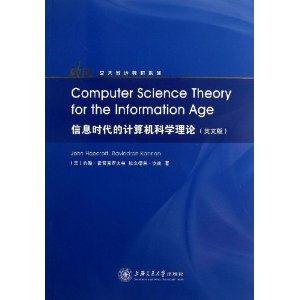-
>
决战行测5000题(言语理解与表达)
-
>
软件性能测试.分析与调优实践之路
-
>
第一行代码Android
-
>
深度学习
-
>
Unreal Engine 4蓝图完全学习教程
-
>
深入理解计算机系统-原书第3版
-
>
Word/Excel PPT 2013办公应用从入门到精通-(附赠1DVD.含语音视频教学+办公模板+PDF电子书)
信息时代的计算机科学理论-(英文版) 版权信息
- ISBN:9787313096098
- 条形码:9787313096098 ; 978-7-313-09609-8
- 装帧:一般胶版纸
- 册数:暂无
- 重量:暂无
- 所属分类:>
信息时代的计算机科学理论-(英文版) 本书特色
《信息时代的计算机科学理论(英文版)》是上海交通大学致远教材系列之一,由国际著名计算机科学家约翰·霍普克罗夫特教授和拉文德兰·坎南教授编写。本书包含了高维空间、随机图、奇异值分解、随机行走和马尔可夫链、学习算法和VC维、大规模数据问题的算法、聚类、图形模型和置信传播等主要内容,书后有附录及索引。从第2章开始,每章后面均附有适量的练习题。 本书可作为计算机及相关专业高年级本科生或研究生的教材,也可供相关专业技术人员参考。
信息时代的计算机科学理论-(英文版) 内容简介
《信息时代的计算机科学理论(英文版)》是交大致远教材系列之一,由约翰·霍普克罗夫特编著。《信息时代的计算机科学理论(英文版)》简介:Computer Science Theory for the Information Age covers the computer science theory likely to be useful in the next 40 years, including high- dimensional space, random graphs, singular value decomposition. random walks, Markov chains, learning algorithms, VC-dimension, algorithms for massive date problems, clustering. The book also covers graphical models and belief propagation, ranking and voting, sparse vectors, and compressed sensing.The book is intended for either an undergraduate or a graduate theory course in computer science.Prof. John Hopcroft is a world-renowned scientist and an expert on education in computer science. He was awarded the A. M. Turing Award in 1986 for his contributions in theoretical computing and data structure design. Dr. Ravindran Kannan is a principal researcher with Microsoft Research Labs located in India.
信息时代的计算机科学理论-(英文版) 目录
- >
推拿
推拿
¥12.2¥32.0 - >
小考拉的故事-套装共3册
小考拉的故事-套装共3册
¥36.7¥68.0 - >
巴金-再思录
巴金-再思录
¥14.7¥46.0 - >
我与地坛
我与地坛
¥15.4¥28.0 - >
大红狗在马戏团-大红狗克里弗-助人
大红狗在马戏团-大红狗克里弗-助人
¥5.1¥10.0 - >
月亮与六便士
月亮与六便士
¥18.1¥42.0 - >
名家带你读鲁迅:故事新编
名家带你读鲁迅:故事新编
¥13.0¥26.0 - >
诗经-先民的歌唱
诗经-先民的歌唱
¥13.5¥39.8
-
Photoshop 2022中文版案例教程
¥44.1¥59.8 -
局域网组建、管理与维护(第4版)(微课版)
¥47¥59 -
园林AUTOCAD教程
¥24¥45 -
Python实战编程:从零学Python
¥81¥108 -
Java程序设计基础
¥37¥50 -
数据备份与恢复
¥51.4¥69




















